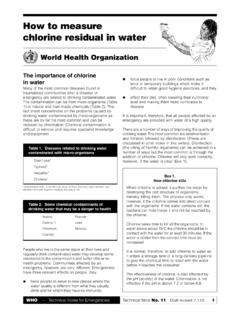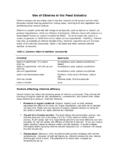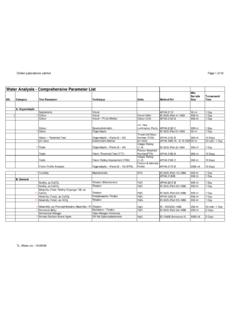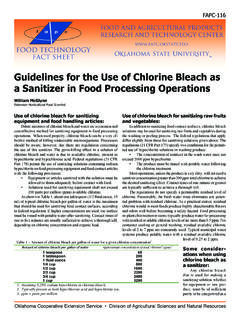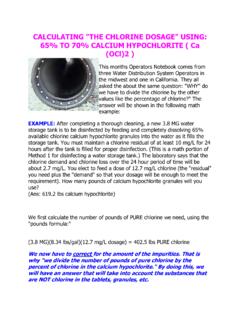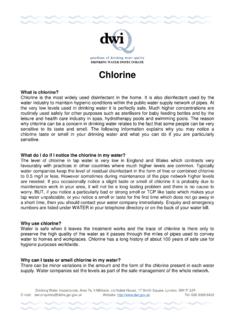Transcription of 11 - WHO
1 TECHNICAL NOTES ON DRINKING-WATER, SANITATION AND HYGIENE IN EMERGENCIES Updated: July NOTES ON DRINKING-WATER, SANITATION AND HYGIENE IN EMERGENCIESM easuring chlorine levels in water supplies11As the quality of water can be seriously affected by a disaster or an emergency, it is best practice to disinfect all emergency water supplies. The most common way of disinfecting is with chlorine . This technical note explains why disinfection is important, why chlorine is used, how it works, how to test for its presence and where and when to should emergency water supplies be disinfected?When disaster strikes a stable community with access to drinking-water of a certain quality, their situation changes: Disasters often damage existing water supplies leading to contamination or further contamination of the supply.
2 People sometimes have to move to new locations and are forced to drink water from new sources for which they have no natural immunity to its contamination. Disasters frequently affect people s physical and psychological health, making them more susceptible to infection and is important, therefore, that all people affected by a disaster are provided with access to safe drinking-water. There is a wide variety of methods for improving the quality of drinking-water, many of which are discussed in Technical Notes 4 and 5. Most of these treatment processes are designed to prepare the water for disinfection, which is the final stage in the treatment is disinfection?
3 Many of the diseases that affect traumatized communities are caused by micro-organisms carried in drinking-water. Hence the reference to water-borne diseases. Disinfection is the process of destroying these organisms to prevent infection. There are a number of methods of disinfecting water, but chlorination is by far the most common. Table lists the advantages and disadvantages of using chlorine for disinfection. How does chlorine work?When chlorine is added to water, it destroys the membrane of many microorganisms and kills them. However, it is ineffective against some cysts, such as cryptosporidium, which are resistant to chlorine disinfection due in part to their thick outer wall.
4 The process only works, however, if the chlorine comes into direct contact with the organisms. If the water contains silt, the bacteria that reside within it may not be reached by the chlorine . chlorine disinfects water but does not purify it: there are some contaminants it cannot remove (see Box overleaf). chlorine takes time to kill organisms. At temperatures of 18OC and above, the chlorine should be in contact with the water for at least 30 minutes. If the water is colder then the contact time must be is normal, therefore, to add chlorine to water as it enters a storage tank or a long delivery pipeline to give the chemical time to perform its disinfecting action before it reaches the consumer.
5 Table Advantages and disadvantages of using chlorine as a disinfectantAdvantagesDisadvantagesIt comes in several forms: powder, granules, tablets, liquid and is usually readily available in one form or another and relatively dissolves easily in provides residual disinfection (see Box ).It is effective against a wide range of disease- causing micro-organisms. It is a powerful oxidizing agent which must be handled with care and breathing chlorine fumes must be does not effectively penetrate silt and organic particles suspended in the can give an unpleasant taste if slightly overdosed, which can dissuade people from using the effectiveness against some organisms requires higher concentrations of chlorine and longer contact ineffective in removing cryptosporidium and where this pathogen is a concern other methods should be used in combination with chlorine ( filtration).
6 Source: Adapted from Davis and Lambert (2002) NOTES ON DRINKING-WATER, SANITATION AND HYGIENE IN EMERGENCIESM easuring chlorine levels in water suppliesThe turbidity and the acidity (pH) of the water have a significant effect on the efficiency of chlorine as a disinfectant. The turbidity should be < 5 NTU and the pH level between and See Technical Note 1 for advice on how to change the pH level of water and measure the references given under Further information page on how to add chlorine to residualWhen chlorine is added to water, it will attack organic matter and attempt to destroy it. If enough chlorine is added, some will remain in the water after all possible organisms have been destroyed.
7 What is left is called free chlorine (Figure ). Free chlorine will remain in the water until it too dissipates or is used to destroy new if water is tested and found to contain some free chlorine , it proves that the most dangerous organisms in the water have been removed and it is likely to be safe to drink. This process is called measuring the chlorine residual (see Figure ).Testing for chlorine residualThe quickest and simplest method for testing for chlorine residual is the dpd (diethyl paraphenylene diamine) indicator test, using a comparator. A tablet of dpd is added to a sample of water, colouring it red. The strength of colour is measured against standard colours on a chart to determine the chlorine concentration.
8 The stronger the colour, the higher the concentration of chlorine in the kits for analysing the chlorine residual in water, such as the one illustrated in Figure , are available commercially. The kits are small and residual protectionMost disinfection methods kill micro-organisms effectively but do not provide any protection against recontamination further along the supply system. chlorine has the advantage of being both an effective disinfectant and its residual can protect the supply downstream from the disinfection chlorine is not a perfect solutionAlthough chlorine does not destroy all micro-organisms, it is still considered to be the most effective emergency disinfectant available because the vast majority of organisms are destroyed.
9 chlorine will not remove chemical contaminants from the water. Chemical contamination is more difficult to remove and requires specialist knowledge and and where to test waterContinuous chlorination is most commonly used in piped water supplies. Regular chlorination of other water supplies is difficult and usually reserved for disinfection after repair and maintenance. It is common to test for chlorine residual at the following points: Just after the chlorine has been added to the water to check that the chlorination process is working. At the outlet of the consumer nearest to the chlorination point to check that residual chlorine levels are within acceptable levels.
10 At the furthest points in the network where residual chlorine levels are likely to be at their lowest. If chlorine levels are found to be below minimum levels (see Box ) it might be necessary to add more chlorine at an intermediate point in the network. Figure chlorine additionChlorine addedInitial chlorine concentrationadded to waterTotal chlorineRemaining chlorineconcentration after chlorinedemand of waterChlorine demandReactions with organicmaterial, metals, othercompounds present in waterprior to disinfectionFree chlorineConcentration of chlorineavailable for disinfectionCombined chlorineConcentration of chlorinecombined with nitrogen in thewater and unavailable fordisinfectionSource.










